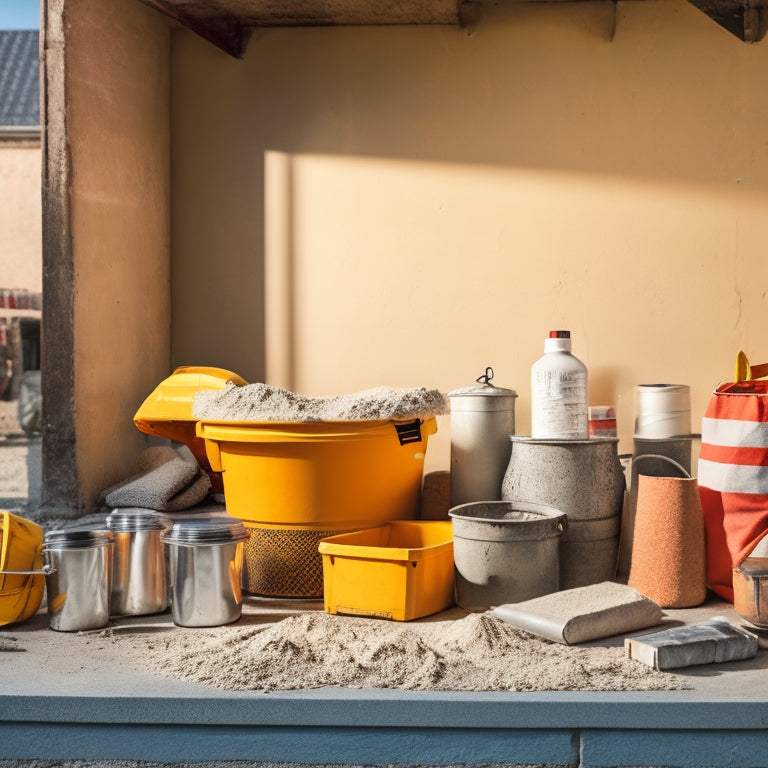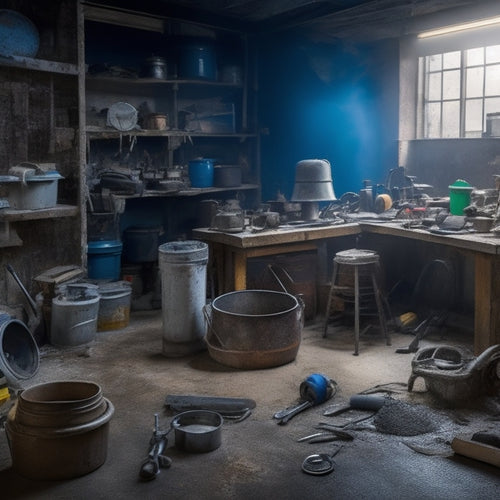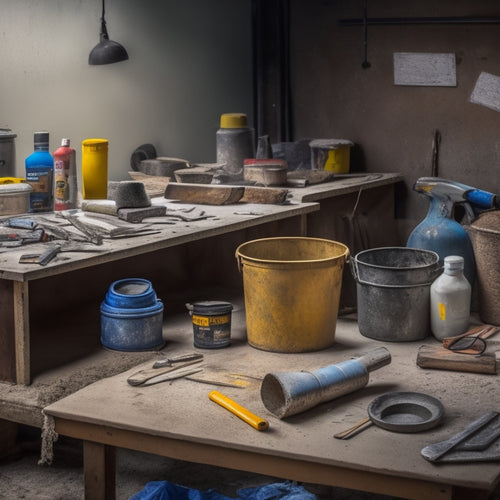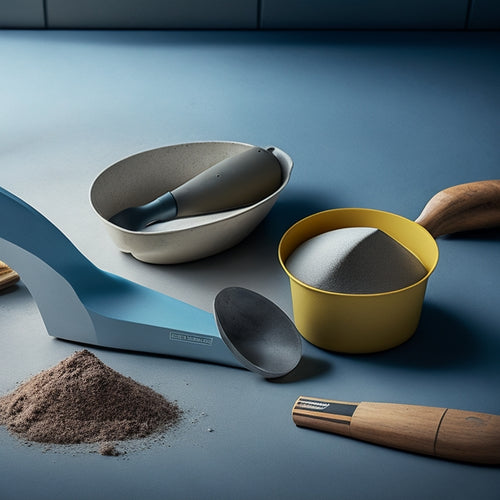
What Tools Do I Need for DIY Concrete Construction
Share
You'll need a variety of tools to achieve professional-looking results in your DIY concrete construction project. For building concrete walls, you'll require a tamping tool, spirit level, rubber mallet, wire brush, and finishing trowel. Mixing and pouring concrete demands a mixer, pouring buckets, pouring chutes, and vibrating screeds. Finishing and smoothening tools, such as tamping rods, leveling screeds, and edge finishers, are also essential. Don't forget safety gear, measuring tools, and concrete cutting and drilling equipment. With the right tools, you'll be well-prepared to tackle your project; now, explore the specific requirements for each stage to guarantee a flawless finish.
Key Takeaways
• Essential tools for DIY concrete construction include tamping tools, spirit levels, rubber mallets, and finishing trowels for building concrete walls.
• Concrete mixing and pouring equipment, such as concrete mixers, pouring buckets, and vibrating screeds, are necessary for a smooth finish.
• Concrete finishing and smoothening tools, including tamping rods, leveling screeds, and vibrating screeds, ensure a flat and even surface.
• Wall forming and shaping tools, such as formwork systems, shaping techniques tools, and modular panels, help create molds for concrete.
• Safety gear and protective equipment, including respiratory protection, protective eyewear, and heavy-duty gloves, are crucial for preventing injuries and health issues.
Essential Tools for Building Concrete Walls
As you commence on building concrete walls, you'll need an arsenal of essential tools to guarantee a strong, durable, and perfectly finished structure.
A sturdy tamping tool, also known as a hand tamper, is crucial for compacting and leveling freshly poured concrete. This guarantees a solid foundation and prevents settling cracks.
Next, a spirit level and laser level will help you achieve precise, plumb walls that exude professionalism.
Don't overlook the importance of a rubber mallet for tapping wall ties into place and a wire brush for cleaning and preparing the surface for finishing.
When it comes to concrete wall aesthetics, a finishing trowel is a must-have for creating a smooth, even finish.
Additionally, consider investing in a thermal imaging camera to detect any gaps or weaknesses in your wall insulation techniques. This proactive approach will save you time and resources in the long run.
Mixing and Pouring Concrete Equipment
You'll need a reliable concrete mixer, capable of handling heavy loads and thorough blending, to produce a consistent, high-quality concrete mixture for your walls.
There are several concrete mixer types to choose from, including drum mixers, paddle mixers, and pan mixers, each with its own strengths and weaknesses. When selecting a mixer, consider the size of your project, the type of concrete you're working with, and the level of control you need over the mixing process.
In addition to a mixer, you'll need the following equipment for mixing and pouring concrete:
-
Concrete pouring buckets: These are large, sturdy buckets with handles, used to transport and pour concrete into place.
-
Pouring chutes: These are long, narrow tubes that attach to the pouring bucket, allowing you to direct the flow of concrete into tight spaces or at a distance.
-
Vibrating screeds: These are handheld or walk-behind tools that help to vibrate and settle the concrete as it's poured, ensuring a smooth, even finish.
Concrete Finishing and Smoothening Tools
When you're working on a DIY concrete project, you'll need the right tools to achieve a smooth, even finish.
You'll be using tamping and leveling tools to guarantee your concrete is perfectly flat and even, and edge and joint finishers to create clean, defined edges.
Tamping and Leveling Tools
Tamping and leveling tools are essential for achieving a smooth, even finish in concrete construction, and you'll need a range of them to guarantee your surfaces are perfectly flat and level.
These tools help you achieve the desired tamping methods and leveling techniques, ensuring a professional-looking finish.
Here are some of the most critical tamping and leveling tools you'll need:
-
Tamping rod: A long, sturdy rod used to compact and flatten the concrete, eliminating air pockets and ensuring a solid foundation.
-
Leveling screed: A long, straight edge used to level and smooth the concrete, guaranteeing a perfectly flat surface.
-
Vibrating screed: A specialized tool that uses vibrations to settle and flatten the concrete, reducing the risk of air pockets and imperfections.
Edge and Joint Finishers
To achieve a professional-looking finish, edge and joint finishers are essential for smoothening and shaping the concrete's edges and joints, ensuring a seamless shift between slabs and a durable, long-lasting structure.
These tools allow you to master advanced edge finishing techniques, such as creating rounded or beveled edges, and joint sealing methods that prevent water infiltration and damage.
You'll need a range of edge and joint finishers to tackle different tasks, including edgers, jointers, and groovers.
Edgers are used to create clean, defined edges, while jointers smooth out joints and prepare them for sealing.
Groovers, on the other hand, create a groove in the concrete for sealants or joint fillers.
By investing in high-quality edge and joint finishers, you'll be able to achieve a flawless finish that enhances the overall appearance and durability of your concrete structure.
With the right tools and techniques, you'll be able to take your DIY concrete construction project to the next level.
Wall Forming and Shaping Tools
You'll need a range of wall forming and shaping tools to create precise, straight, and level concrete walls that meet your design specifications. These tools will help you achieve the desired shape, size, and finish for your concrete walls.
To guarantee accurate and efficient wall construction, consider the following essential tools:
-
Formwork systems: These include modular panels, lumber, and hardware that create a mold for your concrete to set in. Choose a system that suits your project's size and complexity.
-
Shaping techniques tools: These may include trowels, edgers, and floats that help you achieve a smooth, even finish. Invest in high-quality tools that can withstand heavy use.
-
Wall alignment and leveling tools: These include spirit levels, laser levels, and string lines that ensure your walls are perfectly straight and level. Don't compromise on accuracy – it's vital for a professional-looking finish.
Concrete Reinforcement Materials Needed
What specific types of concrete reinforcement materials will you require to guarantee your structure can withstand the stresses and loads imposed on it?
To affirm the structural integrity of your DIY concrete construction project, you'll need to incorporate the right reinforcement types. Steel rebar, also known as reinforcing bar, is a common and effective reinforcement material. It comes in various sizes and shapes, including round bars, deformed bars, and fiber-reinforced polymer (FRP) bars.
You may also consider using wire mesh, which consists of thin steel wires arranged in a grid pattern. This provides additional strength and helps to prevent cracking.
Fiber reinforcement materials, such as synthetic or natural fibers, can also be used to enhance the structural integrity of your concrete structure.
When selecting reinforcement materials, consider factors such as the type of concrete you're using, the size and shape of your structure, and the environmental conditions it will be exposed to.
Safety Gear and Protective Equipment
Wearing the right safety gear and protective equipment is essential when working with concrete, as it can be hazardous to your health and wellbeing. You must prioritize hazard awareness and adhere to strict safety standards to avoid injuries and long-term health problems.
Here are three vital safety items you'll need:
-
Respiratory protection: A dust mask or respirator will prevent you from inhaling concrete dust, which can cause respiratory issues and other health problems.
-
Protective eyewear: Safety glasses or goggles will shield your eyes from flying debris, chemical splashes, and other hazards.
-
Heavy-duty gloves: Thick, puncture-resistant gloves will protect your hands from cuts, abrasions, and chemical exposure.
Measuring and Leveling Tools Required
With your safety gear in place, you can now focus on preparing the site and guaranteeing accurate concrete placement. This requires a set of measuring and leveling tools to assure a precise and even finish.
A 25-foot tape measure is essential for taking precise measurements of the site, forms, and concrete pours. This will help you calculate the exact amount of concrete needed and guarantee accurate placement.
In addition to a tape measure, a laser level is vital for establishing a level plane and detecting any deviations. This tool projects a level line or dot onto the surface, allowing you to accurately assess the site's elevation and make adjustments as needed.
A laser level also helps you maintain a consistent height throughout the pour, guaranteeing a smooth, even finish. By using these measuring and leveling tools, you'll be able to achieve professional-grade results and avoid costly mistakes.
Remember to choose high-quality tools that can withstand the demands of concrete construction, and always follow the manufacturer's instructions for peak performance.
Concrete Cutting and Drilling Tools
You'll need a robust set of concrete cutting and drilling tools to efficiently cut and shape your concrete structures, as well as to create holes for anchoring and reinforcement. These tools will help you make precise cuts, drill accurate holes, and shape your concrete to perfection.
Here are some essential tools you'll need:
-
Concrete Saws: These powerful saws are designed to cut through concrete quickly and efficiently. Look for saws with diamond blades, which are specifically designed for cutting concrete and can withstand the abrasive nature of the material.
-
Diamond Blades: These blades are designed to cut through concrete, asphalt, and other hard materials. They're available in various sizes and are suitable for use with concrete saws, angle grinders, and circular saws.
-
Core Drills: These drills are used to create holes for anchoring and reinforcement. They're available in various sizes and are suitable for drilling holes in concrete, brick, and block.
When selecting concrete cutting and drilling tools, make sure to choose high-quality products that can withstand the demands of concrete construction.
With the right tools, you'll be able to tackle even the most complex concrete projects with confidence and precision.
Cleanup and Removal Equipment Needed
Effective concrete construction projects require efficient cleanup and removal of debris, dust, and excess materials to guarantee a safe and organized worksite. The right equipment is essential for this critical task. You'll need a range of tools to ascertain a thorough cleanup, from brooms and dustpans to vacuums and wet/dry shop vacs. A sturdy shovel or scoop is also necessary for removing larger debris and excess concrete.
When it comes to cleanup techniques, you'll want to prioritize dust control. A dust mask or respirator will protect you from inhaling harmful particles, while a dustless vacuum or HEPA-filter vacuum will minimize airborne dust.
For removal methods, consider investing in a concrete saw or demolition hammer for breaking up and removing large concrete slabs. A pry bar or wrecking bar can also come in handy for prying up and removing stubborn concrete pieces.
Don't forget to include gloves, safety glasses, and a first aid kit in your cleanup arsenal to ascertain your safety throughout the process.
Frequently Asked Questions
Can I Use a Regular Drill for Mixing Small Batches of Concrete?
You're wondering if you can use a regular drill for mixing small batches of concrete. While it's technically possible, it's not the most efficient or effective approach.
A regular drill lacks the torque and mixing capacity needed for concrete. Instead, consider investing in a drill specifically designed for mixing, like a hammer drill or a mixing drill.
These specialized drills will help you master various mixing techniques, ensuring a strong and consistent finish.
Do I Need a Separate Tool for Edging and Jointing Concrete?
You're a DIY warrior, not a one-trick pony! You've got your mixing game on point, but now it's time to tackle the finer details.
Edging techniques and jointing methods require precision and finesse. Don't even think about using that drill for edging - you'll end up with a messy, uneven finish.
Instead, invest in a dedicated edger or jointer, designed specifically for these tasks. These tools will give you the control and accuracy you need to achieve professional-looking results.
Can I Reuse Concrete Wall Forms After the First Pour?
When you're done with the first pour, you'll want to know if you can reuse those concrete wall forms. The answer is yes, but it depends on your concrete form maintenance.
Proper cleaning and storage will extend wall form longevity. Inspect for damage, clean with a pressure washer, and apply a release agent to guarantee the forms are ready for the next use.
With good care, you can reuse them multiple times, saving you time and money on your DIY project.
How Do I Prevent Rust on My Steel Trowel and Other Tools?
You're the master chef of concrete, whipping up a recipe for a durable structure. But, just as a rusty whisk can ruin a soufflé, neglected tools can sabotage your project.
To prevent rust on your steel trowel and other tools, dry them thoroughly after each use and apply a thin layer of oil.
Regularly clean and inspect your tools, and store them in a dry place.
Are There Any Eco-Friendly Alternatives to Traditional Concrete Reinforcement?
You're looking for eco-friendly alternatives to traditional concrete reinforcement, and you're on the right track.
Consider sustainable materials like bamboo, hemp, or jute fibers as natural reinforcements. These alternatives offer similar strength to steel while reducing your carbon footprint.
You can also explore recycled plastic fibers or glass fibers as viable options.
Conclusion
You've got the skills, you've got the plan, now you've got the tools.
From essential equipment for building concrete walls to safety gear and protective equipment, you're all set to tackle your DIY concrete construction project.
Remember to mix and pour with precision, finish and smooth with finesse, and shape and form with accuracy.
With the right tools, you'll be cutting, drilling, and leveling like a pro, and cleaning up with ease.
Get building!
Related Posts
-

7 Tools to Fix Damaged Concrete Floors
You're about to tackle that damaged concrete floor, and the right tools are essential for a successful repair. Start ...
-

3 Best Tools to Buy for Concrete Repair Online
When buying tools for concrete repair online, you'll want to research multiple retailer options to find the best prod...
-

Ergonomic Concrete Tools for Tight Spaces
When you're tackling concrete work in tight spaces, ergonomic tools are your best bet for comfort and efficiency. The...


